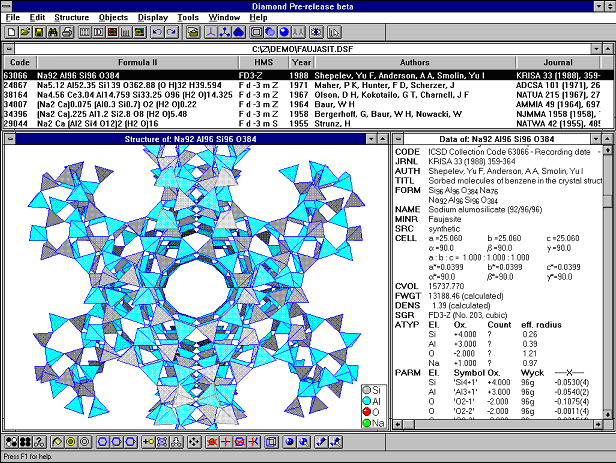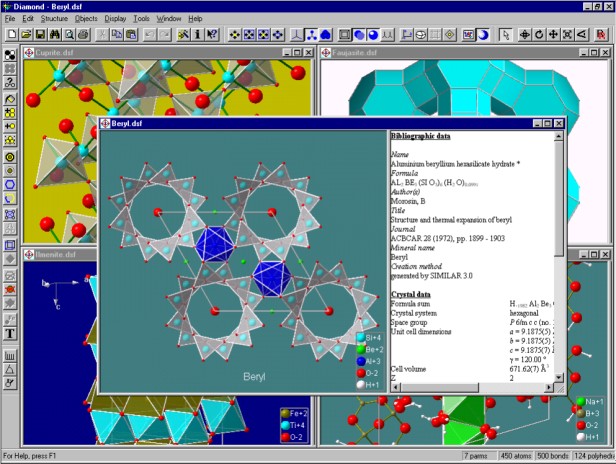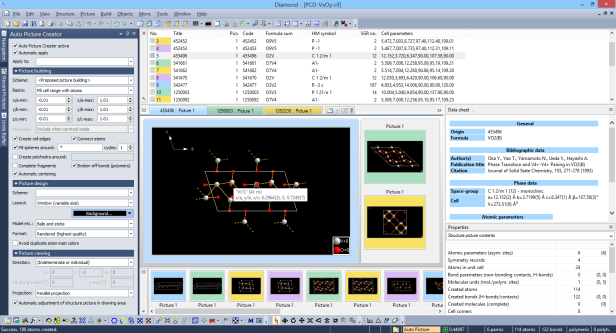Twenty Years of Diamond
It was July 8, 1995, a Saturday, when Klaus Brandenburg stamped the version number 1.0 into the source and into the "Help/About Diamond..." dialog window and declared the first version of Diamond as being ready. Well, as you may know, a software is never "ready", so the date is some kind of arbitrary (some features like thermal ellipsoids came four or five months later, in version 1.0.3 or 1.0.4...) Now that it is ten years and two major versions later, let us have a short review on the development of our crystal and molecular structure drawing software Diamond.
This "20 years of Diamond" anniversary could also be "Klaus
Brandenburg's 25 years in crystal structure visualization", since July
1990 was the time he started development of the crystal structure drawing
software "Crystal Visualizer". This program was delivered in the
1990ies as "ICSD Visualizer" by Fachinformationszentrum (FIZ) Karlsruhe,
Germany, along with the Inorganic Crystal Structure Database (ICSD). No
coincidence, since both Michael Berndt, the author of "ICSD/Retrieve", and
Klaus worked together at the Institute of Inorganic Chemistry at the
University of Bonn, Germany, in the group of Prof. Dr. G. Bergerhoff, one
of the founders of the ICSD.
The actual development of Diamond, from the beginning designed as an MS
Windows application, started in June 1992, using Borland C++ 3.1. As
you can see from the screenshot below (a pre-release version running under MS
Windows 3.1), version 1 was in a way closer to version 3 than Diamond 2
was. You could open a file with multiple datasets at one time, leading to a
configurable table with a data sheet to scroll through.

Version 1 was distributed under the "Prof. Dr. G. Bergerhoff
Software-Entwicklung" from 1995 through 1997 before Klaus
founded Crystal Impact together with Michael Berndt in November 1997. In
September 1996, the development of version 2 started, not continuing
with the old source code but re-designed using Microsoft Visual C++
and the MFC class library.
Version 2.0 was released on June 3, 1998. The key feature of this new
version was the shaded representation of atoms, bonds, etc., making use of the
OpenGL 3D graphics library. The graphics - actually still our favourite poster
- as well as the screenshot below show a composition of different kinds of
structures showing the new capabilities of version 2, such as
transparency, space-filling with correct overlap, shaded ellipsoids etc.

Crystal Impact's engagement in software development for Pauling File ("Binaries Edition" currently distributed by ASM International) and Michael's death on June 30, 2003, caused multiple delays in the development of the next major version 3, which was finally released on October 15, 2004. Amongst several new features like POV-Ray graphics export, powder pattern simulation, this new version can process more than one structure parameter set in a document (file) as well as multiple pictures for a structure parameter set each, as you can see from the screenshot below.

The period between the releases of version 3.0 and 4.0 was a rather long one, even longer than that between versions 2 and 3 before. The reasons were the development of a fourth product (Pearson's Crystal Data, first released in 2007) and the (wrong) decision to add some more features to a version 4 prototype in 2009/10 (with already a lot of enhancements for processing of molecular structures), especially the "Auto Picture Creator" docking pane (cf. the screen shot below). For details, read here...

This heavy delay experience was the key decision to switch over from our conventional model with chargeable major updates and smaller free-of-charge minor updates to our new "subscription model". This subscription model will be introduced with Diamond 5 (while it is already in use with Match! version 3).
Now in 2017, at the time this article has been updated due to the 20th anniversary of the company Crystal Impact, Diamond is already turning to 22 and is used in more than 780 institutions in 59 countries all over the world as research tool as well as a teaching aid. We are looking forward to version 5 subscription, offering a more continuous flow of smaller but more frequent updates.
|

